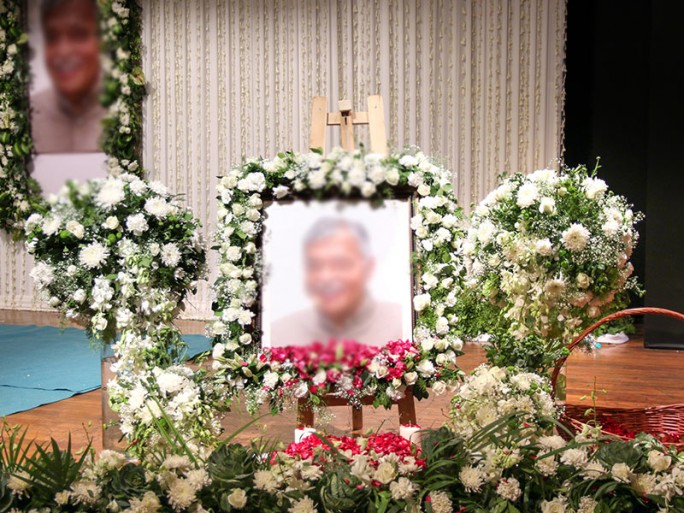Lastjourney Blog
Funeral Ceremony: Everything You Need to Know.

 Table of Contents
Table of Contents Reading Time: 4 minutes
We all know that life is a long expedition in which we explore scores of emotions. The expedition which is in the form of life itself starts with many pleasures and cherishing moments but when it comes to an end, there is a huge void, which can not be replenished. At that juncture, the close companions of the deceased person have nothing to do except mourn and evoke the best times they had together. Throughout life, a human being takes part in many rituals and ceremonies. Hence, the demise of humans can not refrain from the rituals and ceremonies. We collectively call them ” the last rites “.
The funeral ceremony is a part of those rites. It is a procession that occurs at a time between the demise of a person and the cremation or burial of the body. The close relatives, neighbors, colleagues and friends coalesce together and honor the entire journey of a deceased person by remembering his or her accomplishments and showing grief over the void created by the absence of physical appearance.
How it is Distinct in Every Faith?
People belong to various religions and they perform their rites following their beliefs. The funeral ceremony also varies from place to place and person to person. Some listen to the aching music, some talk about the goodness of the deceased one, some sympathize with the bereaving family and some silently think about the way that person chipped in their lives. But the very common thing which everyone does at that time and place is offering the last set of prayers.
Almost every religion offers its specific way to honor the departed soul and guidance to grieving survivors. Here we can have a glimpse of traditions and customs around the death of a few diverse faiths.
Hindu Customs
It is considered that the practitioners of Hinduism are approximately 24 years old. Being one of the archaic religions it has sects and subsects in it. But here we will consider the common proceedings which take place in nearly every region. According to the years-old information, the funeral Service process of the departed soul must be incepted soon after the demise of the person.
What are a few things one must aware of in Hinduism customs related to last rites?
- The body should be laid on the grass floor or a mat.
- The water of the Ganges river can be placed in the mouth of the deceased person along with Tulsi dal if it was not possible to do before the demise.
- The upcoming dawn or dusk whichever occurs first will have opted for the last rites.
- A priest is contacted by the family members to guide them in following the practices related to death.
- The body should be cleaned by close family members but friends or funeral homes could be an alternative if they are not available at that moment.
- During this, the apposite mantras must be chanted by the priest.
- After that, the body should be covered with a new and plain white sheet. If it’s a female body who left the sansaar before her spouse then it must be decorated in red.
- The leading member of the family who has taken the onus of all rituals holds the casket very first and the other members support him.
- It is believed that only male members of the family take part in the cremation ceremony. They put it on the pyre.
- The leading one will walk around the body in the anti-clockwise direction and sprinkle the holy water.
- At last, the pyre will be set on the fire and all the grieving members will wait until it burns entirely. The body of babies is an exception.
Buddhist Customs
According to the Baudh beliefs death is stated as part of a cyclic process and it leads to the further reincarnation of one’s life.
How do the Baudh followers bid adieu to their loved ones?
- The family members, neighbors and friends made a gathering near the deceased person and chant the protective verses or “parittas”.
- A small statue of lord buddha is placed near the head of the body so that the soul can sense calm and comfort.
- Buddhists follow the ” last rites of Amitabha ” for the customary proceedings. It is written there that the body shouldn’t be touched, moved or disturbed after demise as the soul doesn’t leave the body soon after breathing halts.
- Burial and cremation both are allowed in it.
- Before the further process of cremation, the body should be cleaned and unlike in Hindu culture, it should be dressed in usual day clothes.
- During cremation, the group of monks leads the chanting but if they are not present at that moment, it could be done through family members or friends.
- The residual of the cremated body is collected on the very next day. Some keep it, some enshrine in a columbarium and some scatter it at sea.
Islamic Customs
In this faith there are two sects which are commonly known as “Shia” and ” Sunni”. But collectively both the sects believe that the good deeds which they have done on this planet will aid them to enter into paradise.
Know the rituals, a deceased, body of an Islamic follower receives after demise.
- Islamic law which is called “Shariah” allows them only to bury the body of the dead person. This should be done without a delay.
- The Islamic organizations of nearby locality aid the family members in performing the burial and other practices after demise.
- Before burial, the close and same-sex family members wash the body at least three times and it can be repeated numerous times until they assure that the body is perfectly clean.
- If the body belongs to the female gender, the hair should also be washed thoroughly. Then the hair must be braided into three braids.
- They cover the body in a plain white sheet and tie it from the lower and upper parts.
- The body should be taken to the nearby mosque to offer the last set of prayers known as “Salat – Al – Janazah”.
- After that, it is placed inside an earthen cavity and buried.
Life could be tough for those who are left behind and grieve over the immense void of their beloved person. As a human everyone can sense the toughness of saying the ” last goodbye.” But we do not have any alternative except beliving that the departed are now set to
Your email address will not be published. Required fields are marked *












